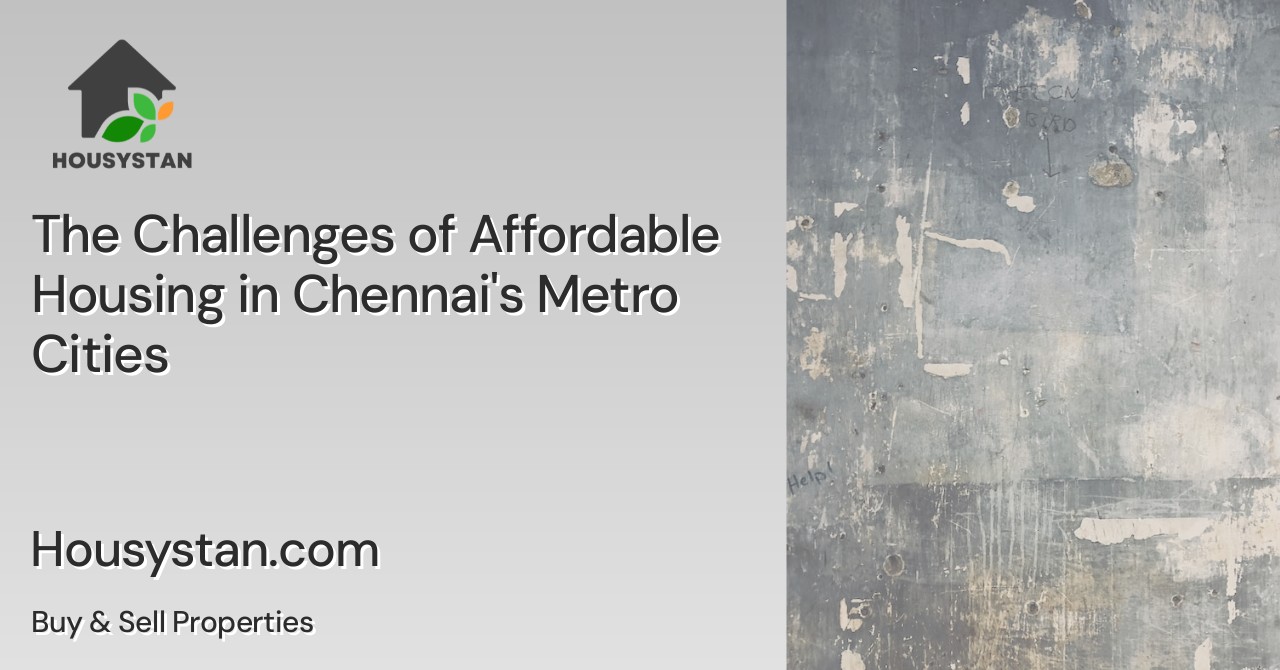The Challenges of Affordable Housing in Chennai's Metro Cities
Read latest blogs and articles from Housystan

The Information mentioned here was last updated on:
4/1/2026The Challenges of Affordable Housing in Chennai's Metro Area
Chennai, a bustling metropolis on the southeastern coast of India, is a city that captivates with its blend of tradition and modernity. As one of India's major cities, Chennai attracts people from across the country seeking employment, education, and better living standards. However, along with this influx comes the significant challenge of providing affordable housing. This blog explores the multifaceted challenges Chennai faces in making housing affordable for its growing population.
Rapid Urbanization and Population Growth
- Verified Tenants/Buyers
- Unlimited Property Listing
- Zero subscription/charges fee
One of the primary challenges is the rapid urbanization that Chennai is experiencing. With a booming population estimated to exceed 10 million, the demand for housing has surged. This spike in population has not been matched by an equivalent expansion in housing infrastructure, leading to a considerable gap between supply and demand. As more people migrate to the city in search of opportunities, the pressure on existing housing structures increases, driving up prices.
Escalating Land Costs
Land costs in Chennai have skyrocketed over the years, making it difficult to develop affordable housing. The prestigious locations close to city centers are often priced out of reach for the average citizen. Even the suburbs, which were traditionally more affordable, are witnessing a sharp increase in land values due to the continuous expansion of the city. This rise in land prices translates to higher construction costs, which in turn are passed on to potential homebuyers and renters.
Limited Availability of Land
Coupled with high costs, the availability of land itself is a significant issue. Chennai's geographic location, bordered by the Bay of Bengal on one side, constrains its expansion. Much of the available land is already occupied, and redeveloping older areas is often fraught with legal and logistical challenges. This limitation makes finding new spaces for housing projects particularly difficult.
Regulatory and Policy Hurdles
The regulatory environment also poses hurdles to affordable housing development. Lengthy approval processes, complex regulations, and demands for compliance with numerous building codes can delay projects and increase costs. While the Tamil Nadu government has initiated several policy measures aimed at boosting affordable housing, the implementation of these policies often lags due to bureaucratic inefficiencies and red tape.
Infrastructure Challenges
A lack of adequate infrastructure further complicates the situation. Many potential housing sites are not serviced by necessary utilities such as water, sewage systems, electricity, and road networks. Developing these sites requires significant investment, which can deter developers from undertaking affordable housing projects. Additionally, within the city, congestion and inadequate public transportation options can make certain areas less desirable despite their lower cost.
Economic Factors
Economic variables also play a critical role in the availability of affordable housing. With inflation rates impacting construction materials and costs, developers face tighter margins, making it less appealing to invest in lower-profit affordable housing projects. Additionally, limited access to low-interest financing options for both developers and potential buyers can pose a barrier.
The Role of Private Developers
Private developers are essential players in delivering housing, but their focus often leans towards more profitable high-end projects. This focus tends to overlook the needs of lower to middle-income families. Developers are cautious about investing in affordable housing due to the perceived risk of lower returns, exacerbated by the issues of land cost, regulatory framework, and economic constraints.
The Impact of Gentrification
Gentrification is another aspect impacting affordable housing in Chennai. As the city develops and modernizes, certain neighborhoods become "upmarket," displacing original residents who can no longer afford the rising property rates. This movement compounds the affordable housing crisis, as displaced residents then seek housing in already crowded and underserved areas.
Social Implications
The lack of affordable housing has far-reaching social implications. It contributes to the growth of informal settlements and slums, which are often poorly constructed and lack essential services. These living conditions can lead to a lower quality of life, impacting health, education, and economic productivity. Overcrowding in these areas can exacerbate public health challenges and increase vulnerability to disasters.
Potential Solutions and Government Initiatives
While the challenges are significant, several initiatives and potential solutions are on the horizon. Government schemes like the Pradhan Mantri Awas Yojana aim to provide significant boosts in affordable housing supply through subsidies and incentives for both supply and demand. Encouraging public-private partnerships could help leverage private sector expertise and funds to address some of the housing shortages.
Relaxation of building norms and expedited approval processes are being examined to help reduce regulatory bottlenecks. Additionally, promoting the development of satellite cities with adequate infrastructure can help decongest Chennai by providing attractive alternative living spaces.
The Importance of Sustainable Development
Sustainability remains a key consideration in tackling Chennai's housing challenges. Emphasizing green building practices and incorporating local materials can reduce construction costs while minimizing environmental impact. Moreover, building robust public transportation connections to new housing areas can make them more viable and livable options.
Conclusion
The quest for affordable housing in Chennai is a complex issue that requires coordinated action from both the public and private sectors. The need for innovative solutions and collaborative efforts is evident to bridge the housing divide and ensure that all of Chennai's citizens have access to safe, comfortable, and affordable homes. Exploring new policies, technological advancements, and strategic urban planning will be essential to meeting the city's housing needs in the coming years.